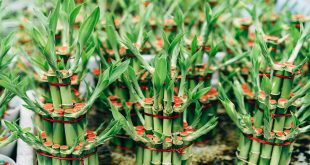Lucky bamboo dies, it can be a result of overwatering, poor lighting or inadequate care. Lucky bamboo is a popular indoor plant known for its symbolism of good luck and positive energy.
However, despite its reputation for being low-maintenance, there are instances when this resilient plant may wither and ultimately die. One of the most common reasons for the death of lucky bamboo is overwatering. While it thrives in water, excessive moisture can cause the roots to rot, leading to the plant’s demise.
Another factor that can contribute to its death is poor lighting. Lucky bamboo requires indirect, bright light to survive, and inadequate illumination can weaken the plant and impact its overall health. Lastly, neglecting other essential care practices, such as proper fertilizer or maintaining a clean environment, can also result in the death of lucky bamboo. Therefore, it is crucial to provide the required conditions and regular care to ensure the longevity of this beautiful and meaningful plant.
Understanding The Significance Of Lucky Bamboo
Lucky bamboo, also known as dracaena sanderiana, is a popular houseplant that has gained attention for its aesthetic appeal and supposed positive energy. This plant, characterized by its long, slender stems and lush green foliage, is often found in homes and offices as a symbol of good luck and prosperity.
Understanding the significance of lucky bamboo involves delving into its symbolism and its historical use in feng shui practices.
Symbolism And Cultural Significance Of Lucky Bamboo:
- Lucky bamboo is associated with various positive meanings across different cultures.
- In china, it is believed to bring good fortune, wealth, and harmony into the household.
- The number of stalks in a lucky bamboo arrangement also holds significance. For instance, two stalks represent love, three bring happiness, and five symbolize wealth and good health.
- The shape of the stalks can also hold symbolic meanings, such as representing the five elements (earth, water, fire, wood, and metal) in feng shui.
Historical Use Of Lucky Bamboo In Feng Shui Practices:
- Feng shui, an ancient chinese practice that aims to harmonize individuals with their environment, has long utilized lucky bamboo for its positive energy.
- The plant is believed to attract positive chi or energy into a space, creating a harmonious ambiance.
- Lucky bamboo is often placed in strategic positions within a room or home to enhance specific areas of life, such as wealth, health, or relationships.
- It is also common to find lucky bamboo in feng shui arrangements, combining it with other elements like crystals or water features to further enhance its energy.
Overall, lucky bamboo holds significance beyond its mere decorative qualities. It carries cultural and symbolic meanings, with its historical use in feng shui practices adding to its allure. By understanding its symbolism and cultural significance, you can better appreciate the beauty and positive energy this plant brings into your space.
Signs Of A Dying Lucky Bamboo Plant
Lucky bamboo, with its sleek, elegant stems, has become a popular choice for indoor plants. But even this hardy plant can face challenges and may wither away if not properly cared for. Keep an eye out for these signs that your lucky bamboo plant is not in the best of health:
Yellowing Or Browning Of Leaves:
- Leaves turning yellow or brown is often one of the first signs that your lucky bamboo plant is struggling.
- It could indicate overwatering or underwatering, as well as insufficient light.
- In some cases, the yellowing or browning may be due to nutrient deficiencies or root rot.
Soft Or Mushy Stems:
- If you notice that the stems of your lucky bamboo plant feel soft or mushy to the touch, it’s a clear sign of trouble.
- Soft stems are often a result of overwatering, which can lead to root rot.
- In severe cases, the stems may even start to develop a foul odor.
Wilting Or Drooping Of The Plant:
- Lucky bamboo is typically known for its upright growth, so any drooping or wilting can be cause for concern.
- This could be a result of too little water, too much direct sunlight, or exposure to drafts.
- It’s important to find the right balance of light, water, and temperature to help your plant thrive.
Remember, catching these signs early on gives you the opportunity to take action and revive your lucky bamboo plant. By providing the care it needs and addressing any underlying issues, you can help ensure its long-lasting beauty in your home or office.
The Impact Of Lucky Bamboo’s Death
What happens if your lucky bamboo dies? The impact of lucky bamboo’s death can go beyond simply losing a beloved plant. Many people believe that there are superstitions and beliefs surrounding the death of lucky bamboo, and it is said to bring negative energy into the environment.
Let’s take a closer look at these aspects:
Superstitions And Beliefs Surrounding A Dead Lucky Bamboo
- Some cultures believe that a dead lucky bamboo is a bad omen and signifies impending misfortune or bad luck.
- In feng shui, lucky bamboo withers and dies due to absorbing negative energy and protecting you from its effects.
- It is believed that the death of lucky bamboo warns you of upcoming challenges and serves as a reminder to take care of your well-being and surroundings.
Negative Energy And Its Effect On The Environment
- According to certain beliefs, the death of lucky bamboo releases negative energy into the environment.
- Negative energy can disrupt the balance and harmony in a space, affecting the overall energy flow and potentially impacting the people within that environment.
- It is important to address the negative energy and cleanse the space to restore positive energy and bring balance back into your surroundings.
Remember, these superstitions and beliefs surrounding the death of lucky bamboo are not scientifically proven, but they hold significant meaning for many individuals. Whether you choose to believe in them or not, taking care of your lucky bamboo and maintaining a positive, balanced environment can contribute to a more harmonious living space.
Factors That Contribute To Lucky Bamboo’s Death
Lucky bamboo is known for its resilience and ability to thrive in a variety of environments, but sometimes, despite our best efforts, it may unexpectedly wither and die. In this section, we will discuss the factors that can contribute to the untimely demise of lucky bamboo.
Understanding these factors can help us provide the proper care and ensure the longevity of this beautiful plant.
Overwatering Or Underwatering
- Overwatering can suffocate the roots, leading to root rot and eventually, the death of the plant. It is crucial to provide adequate drainage and avoid leaving the plant in standing water.
- On the other hand, underwatering can cause the lucky bamboo to dry out and become dehydrated. It is important to monitor the moisture level of the soil and ensure regular watering, keeping it moist but not waterlogged.
Inadequate Sunlight Or Excessive Heat Exposure
- Lucky bamboo thrives in indirect or filtered light conditions. Placing it in direct sunlight can scorch the leaves and cause the plant to wither.
- Excessive heat exposure, especially in hot climates or near heat sources, can also damage the leaves and ultimately lead to the plant’s demise.
Poor Soil Conditions Or Inadequate Drainage
- Lucky bamboo requires well-draining soil to prevent the roots from becoming waterlogged. Using the right potting mix is essential for its overall health.
- If the soil lacks essential nutrients or is of poor quality, it can negatively impact the growth and vitality of the plant.
Taking these factors into consideration, it is important to strike a balance between proper watering, lighting, and soil conditions when caring for your lucky bamboo. By providing the ideal environment and regular maintenance, you can help ensure its longevity and enjoy the beauty of this elegant plant in your home or office.
Steps To Revive A Dying Lucky Bamboo
Is your lucky bamboo looking a bit sickly? Don’t worry, there are steps you can take to revive it and bring it back to its vibrant glory. By assessing the condition of the plant, adjusting watering and light conditions, and pruning and propagating, you can promote new growth and ensure the longevity of your lucky bamboo.
Assessing The Condition Of The Plant:
Before you can revive your dying lucky bamboo, you need to evaluate its condition. Here are some key points to consider:
- Check the color of the leaves: Yellowing leaves may indicate overwatering or too much exposure to direct sunlight, while pale or brown leaves may be a sign of underwatering or inadequate light.
- Inspect the roots: Healthy roots are white and firm, but rotting or mushy roots can indicate overwatering. If the roots appear healthy, the problem may lie elsewhere.
- Consider the overall appearance: Drooping stalks or wilting leaves indicate a stressed or dehydrated plant.
Adjusting Watering And Light Conditions:
The next step in reviving your lucky bamboo is to make adjustments to its watering and light conditions. Here’s what you need to do:
- Watering: Lucky bamboo prefers to be watered with distilled or filtered water. Ensure that the water level is just enough to cover the roots. Overwatering can lead to root rot, while underwatering can cause the plant to wither. Find the right balance by checking the moisture level of the soil regularly.
- Light: Lucky bamboo thrives in bright, indirect light. Avoid exposing it to direct sunlight as it can scorch the leaves. If your plant is not receiving enough light, consider moving it to a brighter spot or supplementing with artificial light.
Pruning And Propagating To Promote New Growth:
Pruning and propagating your lucky bamboo is an effective way to encourage new growth and revive a dying plant. Follow these steps:
- Trim yellowing or unhealthy leaves: Use sterilized scissors or pruning shears to remove any damaged or discolored leaves. This will allow the plant to focus its energy on healthy growth.
- Trim dense or crowded stalks: If your lucky bamboo has become too crowded, carefully remove some of the stalks to create space and improve airflow.
- Propagate healthy cuttings: If you have pruned your lucky bamboo, you can propagate the cuttings in water or well-draining soil. Trim the stems into sections with at least one node and place them in water or soil to encourage root growth.
By following these steps, you can give your lucky bamboo a new lease on life. Remember to assess its condition, make adjustments to watering and light conditions, and prune and propagate to promote new growth. With a little care and attention, your lucky bamboo can bounce back and thrive once again.
Alternatives To Reviving A Dead Lucky Bamboo Plant
Have you recently experienced the unfortunate event of your lucky bamboo plant dying? Don’t worry, it happens to the best of us. Although it may be disheartening to see your once vibrant and thriving plant wilt away, there are alternatives to reviving a dead lucky bamboo.
In this section, we will explore two options that can bring luck, prosperity, and greenery into your space: using feng shui substitutes and transitioning to other low-maintenance indoor plants.
Using Feng Shui Substitutes For Luck And Prosperity
- Crystals: Certain crystals, such as citrine and pyrite, are believed to attract wealth and abundance. Place these crystals in your living space to enhance the energy and bring good fortune.
- Lucky charms: From traditional chinese ornaments like red tassels and coins to other symbols associated with luck and prosperity, incorporating these items in your home can create a positive and auspicious atmosphere.
- Feng shui plants: Choose plants that are known for their luck-bringing qualities, such as the money tree (pachira aquatica) or the jade plant (crassula ovata). These plants are believed to bring financial prosperity and are relatively easy to care for.
Transitioning To Other Low-Maintenance Indoor Plants
- Snake plant (sansevieria): Known for its air-purifying abilities, the snake plant is a resilient and low-maintenance option. It can tolerate low light conditions and irregular watering.
- Pothos (epipremnum aureum): This trailing vine plant is perfect for beginners. With its heart-shaped leaves and ability to thrive in various light conditions, it adds a touch of green to any space.
- Zz plant (zamioculcas zamiifolia): If you have a tendency to neglect your plants, the zz plant is an excellent choice. It can survive in low light and requires minimal watering, making it ideal for busy individuals.
Remember, while lucky bamboo is known to bring good fortune, its death doesn’t have to be the end of luck and prosperity in your home. By exploring feng shui substitutes and transitioning to other low-maintenance indoor plants, you can create an environment that attracts positive energy and adds greenery to your space.
So don’t despair, there are plenty of options available to bring luck back into your life.
Proper Care Tips To Prevent Lucky Bamboo From Dying
Lucky bamboo is a popular houseplant known for its ability to bring positive energy and good luck into a space. However, like any other plant, it requires proper care to thrive and avoid wilting away. To ensure the longevity of your lucky bamboo, it is essential to pay attention to the following factors:
Ideal Watering And Light Conditions
- Watering: Lucky bamboo is a species that prefers its roots to be constantly moist. Keep the plant’s roots submerged in water, about an inch or two, and change the water every 1-2 weeks. Use filtered or distilled water to avoid the buildup of chemicals that can harm the plant.
- Light: Lucky bamboo thrives in bright, indirect light. Place your plant in a location where it can receive gentle, filtered sunlight. Avoid exposing it to direct sunlight, as it can scorch the leaves. If the leaves start turning yellow or brown, it may be an indication of too much light exposure.
Choosing The Right Potting Soil And Containers
- Soil: Lucky bamboo doesn’t require soil to grow. Instead, it can flourish in water alone. However, if you prefer using soil, opt for a well-draining potting mix suitable for indoor plants. Make sure the soil is not too compact, allowing water to pass through easily and preventing root rot.
- Containers: Select a container for your lucky bamboo that has enough space for the roots to grow. Glass vases or ceramic pots are commonly used. Ensure the container is clean and free from any residue that could contaminate the water or soil.
Regular Maintenance And Grooming Practices
- Cleaning: Lucky bamboo plants are prone to collecting dust, which can hinder their growth. To keep them clean, gently wipe the leaves with a damp cloth or rinse them under lukewarm water. Avoid using any cleaning products or harsh chemicals.
- Trimming: Maintain the overall shape and appearance of your lucky bamboo by regularly trimming any yellow, dead, or damaged leaves. Use clean, sharp scissors or pruning shears to make an angled cut just above the node.
- Fertilizing: While lucky bamboo can survive without regular fertilization, occasional feeding can promote healthier growth. Use a mild, balanced liquid fertilizer formulated for indoor plants, following the instructions on the label. Apply the fertilizer once every couple of months during the growing season.
By following these proper care tips, you can safeguard your lucky bamboo from dying and enjoy its beauty and positive energy for a long time. Remember to monitor the watering and light conditions, choose suitable soil and containers, and regularly maintain and groom the plant.
With a little attention and care, your lucky bamboo will thrive and bring good luck into your home or office space.
Frequently Asked Questions On What Happens If Your Lucky Bamboo Dies?
Lucky bamboo is a popular plant known for its relatively low maintenance needs and association with good luck and positive energy. However, despite our best efforts, sometimes our lucky bamboo doesn’t make it. So, what happens if your lucky bamboo dies?
In this section, we’ll address some frequently asked questions about what happens when your lucky bamboo meets its demise. Let’s dig in.
What Are The Common Signs That My Lucky Bamboo Is Dying?
Common signs that your lucky bamboo is dying include yellowing leaves, slimy roots, and a foul odor. Also, if the stems are turning brown or black, it’s a clear indication of a dying plant.
How Can I Revive A Dying Lucky Bamboo Plant?
To revive a dying lucky bamboo plant, start by removing it from its current container and rinsing the roots under running water. Trim any brown or mushy roots and replant the bamboo in fresh, clean water. Ensure it receives indirect sunlight and change the water every other week to maintain its health.
Can Overwatering Cause Lucky Bamboo To Die?
Yes, overwatering can cause lucky bamboo to die. It is important to maintain proper watering practices by keeping the roots moist but not submerged in water for extended periods. Regularly check the water level and drainage of the container to prevent overwatering and root rot.
Is It Possible To Revive A Completely Wilted Lucky Bamboo?
Unfortunately, if your lucky bamboo has completely wilted and turned brown, it is unlikely to revive. However, it’s worth trimming the dead parts and replanting the remaining healthy stems, as they may still have a chance of regrowth.
Can Lucky Bamboo Die From Lack Of Sunlight?
Lucky bamboo can survive in low-light conditions, but prolonged lack of sunlight may cause it to weaken and eventually die. It is best to place your lucky bamboo in an area with indirect sunlight for a few hours each day to ensure its health and vibrant growth.
What Should I Do If My Lucky Bamboo Seems To Be Dying After Repotting?
If your lucky bamboo appears to be dying after repotting, carefully remove it from the new container and inspect the roots. Trim any damaged or rotting roots, then replant the bamboo in fresh, well-draining soil. Place it in a location with indirect sunlight and follow proper watering techniques to promote recovery.
Conclusion
If your lucky bamboo unfortunately dies, it is crucial to identify the possible causes and take immediate action. As a low-maintenance plant, lucky bamboo typically thrives in indirect sunlight, filtered water, and a well-drained pot of pebbles or soil. Factors like overwatering, poor water quality, direct sunlight, inadequate nutrition, or diseases can lead to its demise.
By providing optimal conditions, such as proper watering and lighting, you can prevent your lucky bamboo from dying prematurely. However, if it does happen, it’s important not to lose hope. Consider salvaging any healthy stems and propagating them to give your lucky bamboo a second chance.
Remember to address any underlying issues that may have caused the death to ensure the well-being of future plants. By understanding the reasons behind your lucky bamboo’s demise and implementing preventative measures, you can enjoy the beauty and serenity this plant brings to your home or office.
 GardenXpert Garden Advice Blog
GardenXpert Garden Advice Blog





